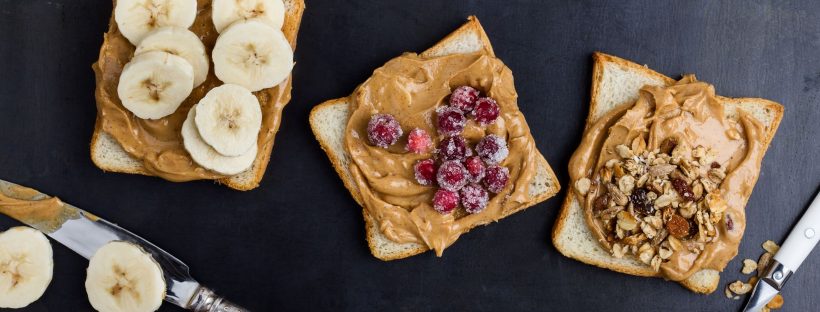We have been eating them as did our parents and we have made them for our children. They entered the world of American cuisine in the early 1900’s. Peanut butter and jelly sandwiches that is.
The ingredient list is short: peanut butter, jelly, and bread. The taste is like no other comfort food. It fits the bill of a food that multi-tasks, combining ease of preparation, convenience, simplicity, nutrition. Plus, they are economically delicious.
The Choices Are Endless
Taken to the next level, there are choices to be made.
Crunchy or smooth peanut butter, natural, low salt or reduced fat. Or hold the peanuts and go for the almond butter or another nut spread such as cashew, sunflower or soynut.
Jam, jelly, or low sugar.
Whole grain bread, multigrain, white wheat flour.
It may seem complicated now, but back to the drawing board or cutting board.
The PB
Peanut butter and other nut butters are a concentrated source of calories and fat. A serving of two tablespoons is about 190 calories and 16 grams of fat. This may make a dent in your calorie allotment, but is worth it for the protein, fiber, vitamins and minerals that come along with that investment. Also, there appears to be a correlation of consuming nuts and a lower risk of heart disease and cancer.
Crunchy or smooth peanut butters are a personal preference. Consume natural peanut butter with little to no added fat and sugar. The reduced fat varieties tend to have the same caloric content as the regular if more sugar is added. That may negate the benefit of less fat. For variety, try other nut butters including almond, sunflower, cashew and soy.
The J
Jam is a combination of whole fruit, water and sugar that is cooked resulting in a thick, chunky spread. Jelly is made from juice and has a thinner consistency and is sweeter. Even though fruit is sweet and has natural sugars, sugar is added to make jam or jelly. They don’t contain fat but do have calories from carbohydrates. Consider a low sugar option.
Fruit butters, despite their name, are not made with butter but are spreadable. Therefore, the name includes butter. One of the best choices to top the peanut butter is fruit. Sliced apples, pears, raisins or bananas are all winners.
The Bread
Most breads are made from wheat flour but that doesn’t mean whole wheat. With the focus on getting more whole grains in our diet, look for breads that list “whole” grain as the first ingredient. Examples include whole wheat and whole oats. Bread may be made with multiple grains, but if they are not whole grains, put the loaf back on the shelf. Regular whole-wheat is made from red wheat and is darker in color with a different taste and texture.
For those who miss white bread, white whole wheat bread may be the answer since it is made with whole grains and has that familiar “white bread” feel and taste. White whole wheat is made from white wheat, is lacking bran color, and has a softer texture and milder flavor. For children or some adults that say they don’t like whole wheat, white whole wheat may be the answer.
How do you make your PB&J?
Share with us in the comments.
- Healthy Snacking Tips from a Football Party Veteran - February 2, 2022
- Why I Will Be in Line for A Flu Shot This Year - February 21, 2021
- Small Steps to Prevent Big Falls: Protecting Older Adults from Injury - February 20, 2021


